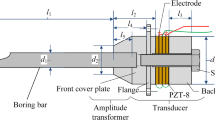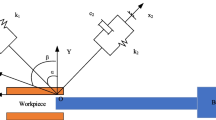Abstract
To effectively cope with the hard machinability challenges of hole caused by difficult-to-cut materials and high processing standards in aviation field, ultrasonic vibration–assisted boring (UB) methods with different modes are proposed. In this paper, the kinematics characteristics of UB were analyzed, the motion trajectory of tool was discussed. The comparison experiment of conventional boring and UB with longitudinal vibration and longitudinal-torsional vibration was performed to study the effect of ultrasonic field on the boring process, the influence of main parameters on boring force and surface roughness were investigated. The results show that UB can reduce boring force and surface roughness effectively, especially with the help of longitudinal-torsional vibration, compared with the conventional boring, the boring force could be reduced by 38.04–43.77%, and the surface roughness could be reduced by 25.48–41.47%. This study proves the feasibility of UB and provides theoretical and experimental reference for improving the surface quality of difficult-to-machine holes.








Similar content being viewed by others
Data availability
All data generated or analyzed during this study are included in this published article.
References
Prasanna J, Karunamoorthy L, Venkat-Raman M, Prashanth S, Raj Chordia D (2014) Optimization of process parameters of small hole dry drilling in Ti-6Al-4V using Taguchi and grey relational analysis. Measurement 48:346–354. https://doi.org/10.1016/j.measurement.2013.11.020
Fu L, Fan Y (2008) A solution for PCB drilling with strict requirement on hole wall quality. Circuit World 34(2):8–11. https://doi.org/10.1108/03056120810874528
Aamir M, Giasin K, Tolouei-Rad M, Vafadar A (2020) A review: drilling performance and hole quality of aluminium alloys for aerospace applications. J Market Res 9(6):12484–12500. https://doi.org/10.1016/j.jmrt.2020.09.003
Sun D, Lemoine P, Keys D, Doyle P, Malinov S, Zhao Q, Qin X, Jin Y (2018) Hole-making processes and their impacts on the microstructure and fatigue response of aircraft alloys. Int J Adv Manuf Technol 94:1719–1726. https://doi.org/10.1007/s00170-016-9850-3
Funabiki T, Hirogaki T, Aoyama E, Ogawa K, Kodama H (2012) Investigation of micro-drilling for printed circuit boards containing high-hardness fillers. Adv Mater Res 565:442–447. https://doi.org/10.4028/www.scientific.net/AMR.565.442
Li XB, Zheng JM, Li Y, Kong LF, Shi WC, Guo B (2018) Modeling and distribution laws of drilling force for staggered teeth BTA deep hole drill. Math Probl Eng 111(5–6):1721–1733. https://doi.org/10.1155/2018/3691468
Katsuki A, Onikura H, Sajima T (2011) Development of a practical high-performance laser-guided deep-hole boring tool: improvement in guiding strategy. Precis Eng 35(2):221–227. https://doi.org/10.1016/j.precisioneng.2010.12.003
Xiao WR, Zi YY, Chen BQ, Li B, He ZJ (2014) A novel approach to machining condition monitoring of deep hole boring. Int J Mach Tools Manuf 77:27–33
Dai GL, Hui YH, Jin KK (2003) Design and manufacture of a carbon fiber epoxy rotating boring bar. Compos Struct 60(1):115–124. https://doi.org/10.1016/S0263-8223(02)00287-8
Matsubara A, Maeda M, Yamaji I (2014) Vibration suppression of boring bar by piezoelectric actuators and LR circuit. CIRP Ann Manuf Technol 63(1):373–376. https://doi.org/10.1016/j.cirp.2014.03.132
Zhang C, Cong W, Feng P, Pei Z (2014) Rotary ultrasonic machining of optical K9 glass using compressed air as coolant: a feasibility study. Proc Inst Mech Eng B J Eng Manuf 228(4):504–514. https://doi.org/10.1177/0954405413506195
Li ZC, Jiao Y, DeInes TW, Pei ZJ, Treadwell C (2005) Rotary ultrasonic machining of ceramic matrix composites: feasibility study and designed experiments. Int J Mach Tools Manuf 45(12–13):1402–1411. https://doi.org/10.1016/j.ijmachtools.2005.01.034
Ding K, Fu Y, Su H, Chen Y, Yu X, Ding G (2014) Experimental studies on drilling tool load and machining quality of C/SiC composites in rotary ultrasonic machining. J Mater Process Technol 214(12):2900–2907. https://doi.org/10.1016/j.jmatprotec.2014.06.015
Lian H, Guo Z, Huang Z, Tang Y, Song J (2013) Experimental research of Al6061 on ultrasonic vibration assisted micro-milling. Procedia Cirp 6(7):561–564. https://doi.org/10.1016/j.procir.2013.03.056
Xu WX, Zhang LC, Wu YB (2016) Effect of tool vibration on chip formation and cutting forces in the machining of fiber-reinforced polymer composites. Mach Sci Technol 20(2):312–329. https://doi.org/10.1080/10910344.2016.1168930
Chern GL, Chang YC (2006) Using two-dimensional vibration cutting for micro-milling. Int J Mach Tools Manuf 46(6):659–666. https://doi.org/10.1016/j.ijmachtools.2005.07.006
Xu LH, Na HB, Han GC (2018) Machinability improvement with ultrasonic vibration-assisted micro-milling. Adv Mech Eng 10(12):1–12. https://doi.org/10.1177/1687814018812531
Li Z, Zhang D, Jiang X, Qin W, Geng D (2017) Study on rotary ultrasonic-assisted drilling of titanium alloys (Ti6Al4V) using 8-facet drill under no cooling condition. Int J Adv Manuf Technol 90(9):3249–3264. https://doi.org/10.1007/s00170-016-9593-1
Kurniawan R, Kiswanto G, Ko TJ (2017) Surface roughness of two-frequency elliptical vibration texturing (TFEVT) method for micro-dimple pattern process. Int J Mach Tools Manuf 116:77–95. https://doi.org/10.1016/j.ijmachtools.2016.12.011
Zheng W, Wang YJ, Zhou M, Wang Q, Ling L (2018) Material deformation and removal mechanism of SiCp/Al composites in ultrasonic vibration assisted scratch test. Ceram Int 44:15133–15144. https://doi.org/10.1016/j.ceramint.2018.05.150
Lotfi M, Amini S, Aghaei M (2018) 3D FEM simulation of tool wear in ultrasonic assisted rotary turning. Ultrasonics 88:106–114. https://doi.org/10.1016/j.ultras.2018.03.013
Zhu L, Hu X, Jiang R, Song Y, Qu S (2019) An investigation of small fatigue crack behavior in titanium alloy TC4 under different stress levels. Proceedings of the Institution of Mechanical Engineers 233(15):5567–5578. https://doi.org/10.1177/0954410019852867
Guo P, Zhao Y, Zeng W, Hong Q (2013) The effect of microstructure on the mechanical properties of TC4-DT titanium alloys. Materials Science and Engineering A: Structural Materials: Properties, Microstructure and Processing 563(FEB.15):106–111. https://doi.org/10.1016/j.msea.2012.11.033
Li M, Huang M, Chen Y, Gong P, Yang X (2019) Effects of processing parameters on kerf characteristics and surface integrity following abrasive waterjet slotting of Ti6Al4V/CFRP stacks. J Manuf Process 42:82–95. https://doi.org/10.1016/j.jmapro.2019.04.024
Wang XB, Jiao D, Wang D, Niu Y (2019) Development of a longitudinal-torsional ultrasonic vibration-aided drilling system for drilling carbon fiber-reinforced polymer materials. Proc Inst Mech Eng C J Mech Eng Sci 233:1989–1996. https://doi.org/10.1177/0954406219833084
Funding
This research is supported by the National Science and Technology Major Project of China (Grant No.2017-VII-0002–0095), and the Aeronautical Science Foundation of China (Grant No. 2020Z045053001).
Author information
Authors and Affiliations
Contributions
Danni Lu designed the framework of the thesis, carried out the experiments, and provided data analysis, Yaoyao Shi contributed to the main idea of this paper, Pan Zhao participated in the writing of this paper.
Corresponding author
Ethics declarations
Ethics approval and consent to participate
Not applicable.
Consent for publication
All authors have read and agreed to the published version of the paper.
Conflict of interest
The authors declare no competing interests.
Additional information
Publisher's Note
Springer Nature remains neutral with regard to jurisdictional claims in published maps and institutional affiliations.
Rights and permissions
About this article
Cite this article
Lu, D., Shi, Y. & Zhao, P. Theoretical and experimental investigations of ultrasonic vibration–assisted boring for titanium alloy. Int J Adv Manuf Technol 121, 2169–2179 (2022). https://doi.org/10.1007/s00170-022-09485-6
Received:
Accepted:
Published:
Issue Date:
DOI: https://doi.org/10.1007/s00170-022-09485-6




